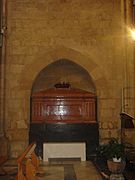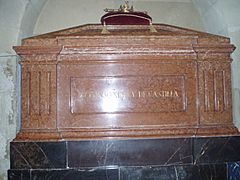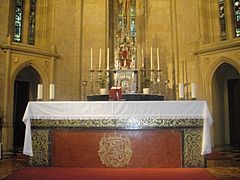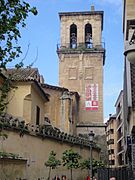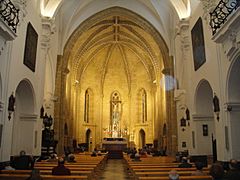Royal Collegiate Church of Saint Hippolytus facts for kids
Quick facts for kids Royal Collegiate Church of Saint Hippolytus |
|
|---|---|
|
Real Colegiata de San Hipólito
|
|
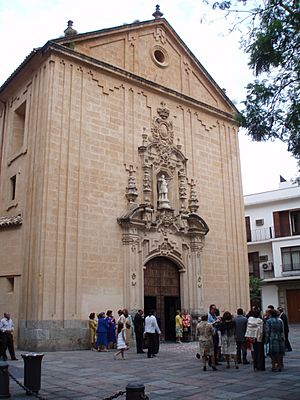 |
|
| Religion | |
| Affiliation | Roman Catholic |
| Region | Andalusia |
| Patron | Saint Hyppolytus of Rome |
| Location | |
| Location | Córdoba, Spain |
| Country | Spain |
| Architecture | |
| Architectural style | Gothic and Baroque |
| Groundbreaking | 1343 |
| Completed | 1736 |
The Royal Collegiate Church of Saint Hippolytus (known as Real Colegiata de San Hipólito in Spanish) is a Catholic Church located in Córdoba, Spain. King Alfonso XI of Castile started building this church in 1343. Today, the Jesuits manage the church. It is also the resting place for two kings: Ferdinand IV and his son Alfonso XI.
Contents
Why Was the Church Built?
The Royal Collegiate Church of Saint Hippolytus was planned as part of a monastery. King Alfonso XI of Castile wanted to build it in 1343. He wanted to celebrate a big victory. This victory was the Battle of Salado, which happened in 1340. The king also wished for this church to be his final resting place. He also wanted his father, Ferdinand IV, to be buried there. Ferdinand IV had passed away in 1312. He was first buried in the Mosque–Cathedral of Córdoba.
How the Church Became Special
On August 1, 1347, Pope Clement VI made the church a "collegiate church." This meant it could hold special religious services. These services would honor the kings. King Alfonso XI really admired Saint Hippolytus. He ordered special masses to be held. These masses were for his ancestors' souls. They were held on different days. A very important day was Saint Hippolytus's feast day. This day was also King Alfonso's birthday.
Building the Church: A Long Project
Building the church took a very long time. Only the apse (the rounded end) and the crossing (where the main parts meet) were finished. This happened during the reigns of Alfonso XI and his son, King Peter I. The rest of the church was not completed until the 1700s. In 1729, King Philip V of Spain agreed to restart the construction. Seven years later, in 1736, the main work was done. Other parts were added later in the 18th and 19th centuries.
What Happened to the Church Later?
During the time of Queen Isabel II of Spain, the church lost its "collegiate church" title. However, people still call it by that name. It continued to be used for religious services. In the late 1800s, it was given to the Jesuits. They have been in charge of the church ever since.
The Resting Place of Kings
The Royal Collegiate Church of Saint Hippolytus holds the tombs of two important kings. These are King Ferdinand IV and his son, King Alfonso XI.
King Ferdinand IV's Journey
King Ferdinand IV passed away in Jaén in September 1312. A few days later, his body was moved to Córdoba. On September 13, he was buried in a chapel. This chapel was inside the Mosque-Cathedral. Originally, he was supposed to be buried elsewhere. Options included the Cathedral of Toledo or the Cathedral of Seville. But it was very hot in September. So, his wife, Queen Constance, and his brother decided to bury him in Córdoba. It was closer to where he had died.
King Alfonso XI's Burial
King Alfonso XI died in March 1350. He passed away during the Great Plague. This happened during the Fifth Siege of Gibraltar. His body was first buried in the Royal Chapel. This chapel is in the Cathedral of Seville. He had wanted to be buried in the Church of Saint Hippolytus. He wished to be near his father. In 1371, the Royal Chapel in Córdoba's Mosque-Cathedral was finished. Alfonso's son, Henry II, ordered his father's body moved there. So, Alfonso XI was buried next to King Ferdinand IV.
Moving the Kings' Tombs
The tombs of both kings stayed in the Royal Chapel for many years. Then, on the evening of August 8, 1736, they were moved. They were finally transferred to the Church of Saint Hippolytus. This was the place King Alfonso XI had wished for.
On May 12, 2008, the church received a special honor. It was declared a Bien de Interés Cultural. This means it is a Spanish Property of Cultural Interest. Its reference number is RI-51.0012151-0000.
Gallery
See also
 In Spanish: Real Colegiata de San Hipólito (Córdoba) para niños
In Spanish: Real Colegiata de San Hipólito (Córdoba) para niños


